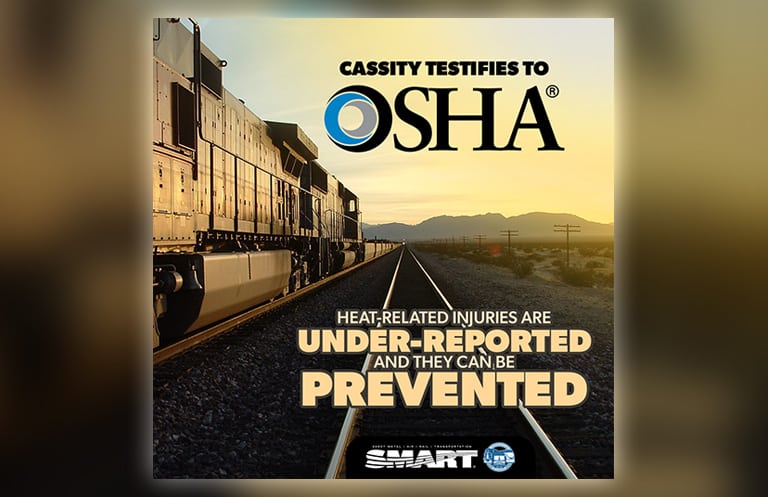
With extreme heat and triple-digit temperatures leaving many of us sweltering this week, it’s impossible to ignore the danger these conditions present to railroad workers.
Some of these heat-related concerns were discussed during Tuesday’s Occupational Safety and Health Administration (OSHA) hearing on its proposed new rule aimed at preventing heat-related injuries and illnesses.
Railroading includes unavoidable heat exposure
SMART-TD is mindful of the dangerous realities of working in the rail industry, which Deputy National Safety and Legislative Director Jared Cassity emphasized in his testimony.
“Railroading is unlike any other job I’ve ever had, despite the fact that all have required me to work outside,” said Cassity. “I think it’s critically important that you understand the nuances of railroading, the existing challenges, and the need for sufficient planning.”
When it comes to the impact that heat has on workers, Cassity notes that the rail industry can sometimes fall through the cracks.
“The risk and the effects of heat are just as real for us as they are for anyone else,” he pointed out. “The exposures are long, the tests are difficult, and the need for proper planning, assessing, monitoring, communicating and training could not be greater.”
A six-mile walk in the sun
With unexpected breakdowns on the rise, often happening in less-than-ideal locations, conductors can quickly feel the effects of heat when making the long trek to the back of their trains.
“[Conductors] can be forced to walk more than three miles on this difficult terrain just to get to the end of their train,” Cassity emphasized. “This takes energy and time, both of which are extremely problematic when exposed to extreme heat. That means without any repairs, just walking, a worker will be in the heat for more than two hours and limited to the water that he or she can carry.”
That “difficult terrain” encompasses a broad range of environments.
“Railroading is not pretty, but it does traverse some of the best and worst landscapes this nation has to offer,” said Cassity. “But that also means that workers are tasked with walking trains in the desert, the mountains, or everything in between. This is where the rule would go a long way toward protecting the men and women working on or with America’s freight trains.”
Lack of regulations is a major problem
Cassity explained that one of the biggest heat safety issues facing rail workers is the lack of functioning air conditioning in the cabs of locomotives, if it exists at all.
Whether you’re moving or stopped, things can get very hot very quickly.
“[In] a locomotive that doesn’t have working air conditioning, you are solely limited to the ambient air that is moving,” Cassity noted. “When you’re moving and when you’re idle, it gets really hot. I mean, if you can imagine sitting in a steel box while the sun beats down…some of the hottest experiences of my life, frankly, have been in a locomotive without working air conditioning.”
Rest without retaliation
According to Cassity, what the railroad industry needs the most is established guidelines that outline when an employee must take a break or what to do when rest, shade, or hydration isn’t immediately available.
That’s usually easier said than done.
“Most members that we represent on Class I railroads probably don’t take rest for fear of the repercussions from management and doing it,” said Cassity. “Even in the middle of summer, it is not something that’s readily talked about. There’s this theory that you can take breaks but knowing when that should occur or how that should occur is really not prevalent, and it’s one of the reasons that we are so firmly supportive of this: plans that protect the worker from discipline when trying to take the safest course and that empower and encourage them to be proactive and seeking breaks from the elements rather than powering through it.”
Class I Railroads Can and Should Improve
During the hearing, the American Short Line and Railroad Association (ASLRRA) said that the proposed rule is “overly burdensome” and shouldn’t apply to railroads, because they’re already regulated by the Federal Railroad Administration (FRA).
The organization added that it already has procedures in place to deal with heat-related emergencies, even though there supposedly aren’t many of them.
Cassity says that’s not the case for larger railroads.
“I also heard a lot of the conversation regarding the data and the suggestion or notion that there’s not very many heat-related injuries. In my experience, we have quite a few. They’re just not reported accurately or appropriately. And to me, that speaks to the fact that they’re not quite equipped to respond to those heat-related emergencies. I do not believe it to be a big lift for them.”
What’s Next
Hearings on OSHA’s proposed rule continue until July 2.
As we’ve said before and as Brother Cassity stressed, the safety and well-being of rail workers cannot be an afterthought.
It’s time for our industry to take responsibility and for OSHA to ensure rail workers get the protection we deserve.
Related News
- Value of Unions
- New Mass. Law Protects SMART-TD Transit Members
- Bills Mount After Texas Conductor Loses a Leg
- 2026 Railroad Retirement and Unemployment Insurance Tax Changes
- SMART General President Michael Coleman praises SMART-TD agreement with Union Pacific, congratulates members on ratification
- SMART Women’s Committee statement on Amber Czech
- SMART-TD Members on UP Properties Ratify Five-Year Agreement
- General President Coleman’s Thanksgiving message to U.S. members
- Railroader’s Son to Perform at Carnegie Hall
- Union Members Head to College Thanks to Tuition Benefit